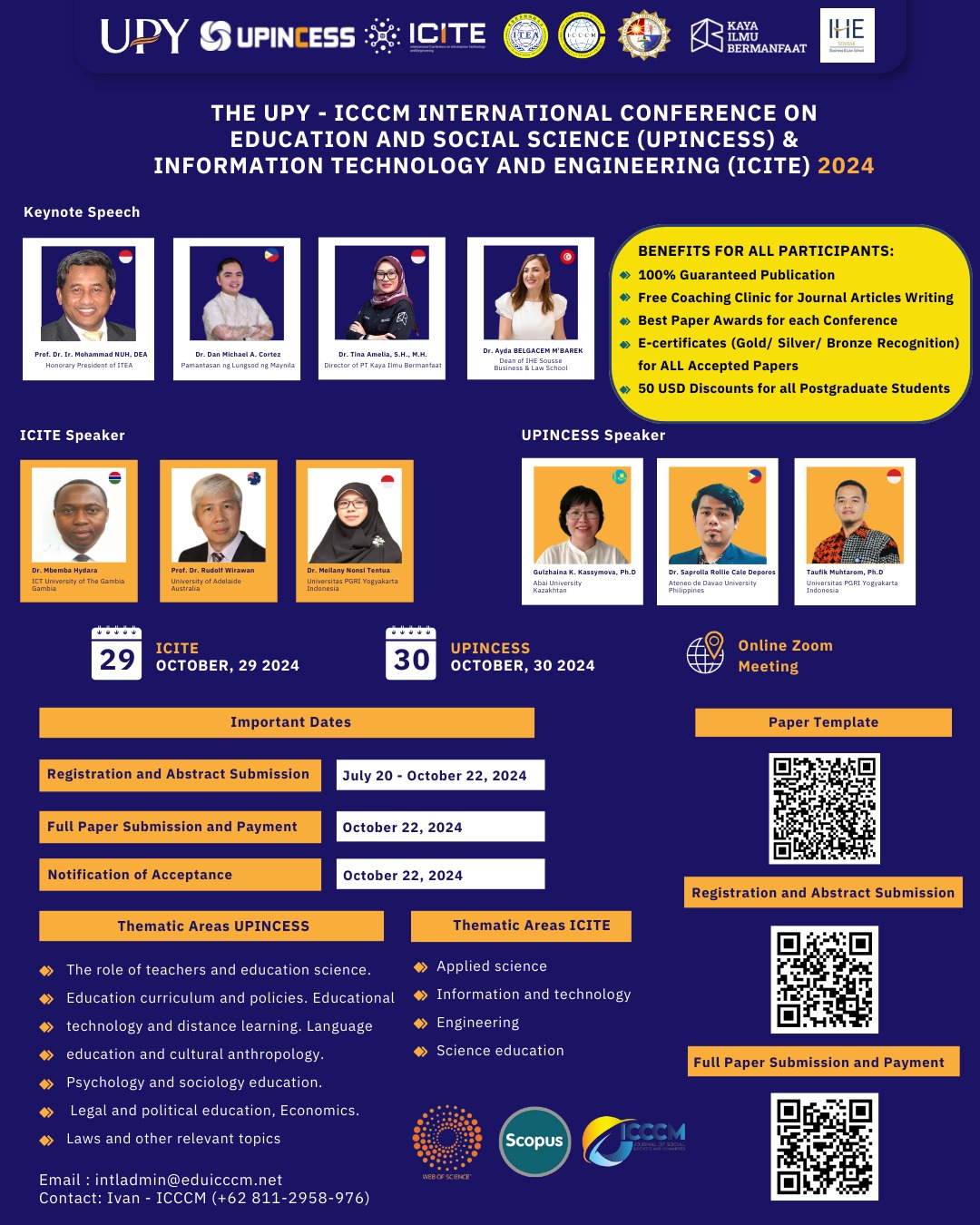Development Of E-APE Interactive Media For Languange Learning For Early Childhood
DOI:
https://doi.org/10.53797/icccmjssh.v3i2.1.2024Keywords:
Early childhood, Language, Interactive Media E-APEAbstract
The research has several objectives including 1) knowing what needed by teachers and students for media for development, 2) making media development designs, 3) analyzing the feasibility of media development and 4) analyzing the has an E base –APE for the continuation of language teaching and learning for early childhood in Donorojo District, Jepara Regency. Research conducted by researchers refres to the theory of brog and gall, namely the process of research and gathering information, planning, initial product development, initial trials, product improvements, field trials, final product improvements and then dissemination. Testing for the level of effectiveness uses a quasy experiment, non-equivalent control group design and documentation prerequisite test carried out included normality tests, homogeneity tests, hypothesis analysis using product validity tests and effectiveness tests using the best T test, This study provided several results including, 1) there is a “needed” for the continuity of language teaching and learning for early childhood in Donorojo District, Jepara Regency, 2) the design of interactive media development which has an E-APE basis named AYOMA or let’s Learn Together with a wide selection of themes such as the theme of yourself, sports, transportation to the environment. The design is presented in electronic from that utilizes a mixture of brown base colors, accompanied by photos, vocabulary to music to attract children’s desire to learn, 3) The level of feasibility of developing E- APE interactive media in the context of teaching early childhood language in Donorojo District, Jepara Regency has very good validity test results on material, language, media, 1,media 2 so that it can be concluded that interactive media that has an E-APE basses suitable for use for teaching snd learning activites, 4) The results show that has an E-APE basis is effective for improve children’s language skills compared to teaching and learning activities that do not utilize interactive media on an E-APE basis.
Downloads
References
Adhani, D.N. 2016. Improve Languange Development With Flash Card Media In Early Childhood In The Village Sanan Rejo Regency Malang. Journal Pg- - Paud Trunojoyo, 3(2): 71–75.
Aisyah, E.N. 2019. Development Of Ritatoon Game Tools About Pets As A Medium For Stimulating Early Childhood Cognitive Abilities. Jktp Journal Of Educational Technology Studies, 2(3): 174–180.
Bloom, Benjamin S., E. 2016. Taxonomy Of Educational Objectives : The Classification Of Educational Goals, Handbook I Cognitive Domain. New York: Longmans, Green And Co
Fitria, N., Fidesrinur, & Zahrawanny. V.P. 2020. The Influence Of Parents’ Perceptions About Early Childhood Education On The Support Of Sending Their Children To Early Childhood Education Institutions. In Proceedings Of The 1st International Conference On Early Childhood Care Education And Parenting (Iceccep 2019) (Pp. 94-98). Atlantis Press.
Harliza, T., & Kurniah, N. (2021). Pengembangan Media Pembelajaran Interaktif Untuk Meningkatkan Kemampuan Bahasa Dan Kognitif Pada Anak Usia Dini ( Studi Pada Kelompok A Kelurahan Talang Ulu ). Diadik: Jurnal Ilmiah Teknologi Pendidikan, 10(2), 254–262. https://doi.org/10.33369/diadik.v10i2.18285
Imaniar Purbasari, Munawir Yusuf, Subagya, Sri Marmoah, Nur Fajrie, & Hisbulloh Als Mustofa. (2023). Bamboo Woven Websites For Elementary School Students Through Social Collaborative Learning Approach. Journal Of Advanced Research In Applied Sciences And Engineering Technology, 31(1), 315–325. https://doi.org/10.37934/Araset.31.1.315325
Mulyasa, H.E. 2016. Preschool Management. Bandung: Pt. Remaja Rosdakarya.
Norita, E. 2021. Development Of Multimedia Based Cognitive Learning Media In Tk Negeri Pembina Padang. Journal Basicedu, 5(2): 561–570
Sun, R.-Q., Sun, G.-F., & Ye, J.-H. (2023). The Effects Of Online Game Addiction On Reduced Academic Achievement Motivation Among Chinese College Students: The Mediating Role Of Learning Engagement. Frontiers In Psychology, 14. Http://Dx.Doi.Org/10.3389/Fpsyg.2023.1185353
Susanti, A., Kasim, U., Achmad, D., Burhansyah, And Nasir, C. 2022. The Use Of Media In Innovative Learning To Improve Students’ Achievement In Learning English. Research In English And Education (Read), 7 (2), 85-90.
Sutopo, A.H. 2017. Information And Communication Technology In Education. Yogyakarta: Graha Knowledge.
Downloads
Published
How to Cite
Issue
Section
License
Copyright (c) 2024 Elok Khafidhoh, Ifrai Fathurohman, Wawan Shokib Rondli

This work is licensed under a Creative Commons Attribution-NonCommercial-ShareAlike 4.0 International License.




